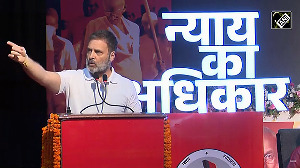Bank of Baroda is spending about Rs 80 crore (Rs 800 million) on a high-profile rebranding campaign, including Rs 5 crore (Rs 50 million) on the brand ambassador, Indian cricket team's captain, Rahul Dravid. In an interview with Rajendra Palande and Abhijit Lele, the bank's chairman, Anil Khandelwal, apoke about the rationale behind the brand relaunch exercise and how it has put pressure on the bank to change. Excerpts:
Bank of Baroda has suddenly become a very visible brand. Rahul Dravid is all over promoting the brand. What prompted you to launch a campaign on such a scale?
BoB has 2,800 branches and 25 million customers but it didn't appear to be a dynamic, throbbing bank. We wanted to change the perception about the bank. That's what made us conceptualise positioning the brand as among the premier financial institutions. The roping in of Rahul Dravid as our brand ambassador was an offshoot of the urge to present the bank as a charismatic frontrunning financial entity.
How have things changed?
Most banks are talking about how their NPAs have reduced and the sizzling growth in loan books. But only BoB is making noise about customers and customer service. It's a reflection of how the organisation is changing.
What was wrong with the earlier brand image?
The earlier BoB brand had no recall value. People had a very cluttered image of the bank. Now that's a thing of the past. The BoB brand now generates a very bright image and it now is highly recallable.
Is there any change in the way you function?
The challenge was to enlist prime customers, a lot that's now being pampered by private sector banks. So we had to take customer convenience initiatives. As many as 350 branches now work from 8 am to 8 pm. We also added 400 ATMs in the last four months and converted eight branches to offer 24-hour banking. The advertisement campaign says it all. We have Dravid saying: "sab kuch badal raha hai ... hamara bank bhi badal raha hai. (Everything's changing ... our bank is also changing)."
What else is being done to improve customer service?
Customer-centric initiatives make the second phase of changes in the banking industry. The first phase involved the efforts to reduce NPAs and the retail lending boom. BoB is now turning into a very sensitive and a caring bank. We've now made the staff accountable for any lacunae in customer service. The days of our front office staff saying "kal aana or baad mein aana" are things of the past. We are working towards a cultural transformation in customer service.
Why was the punch-line "India's International Bank" added to the campaign?
As an Indian Bank, we have 59 offices in 20 countries. We laid a greater stress on saying "India's International Bank" to spur the bank into adopting international best practices in all its business areas. This was to tell the employees that expectation levels have been raised.
Has this worked?
In the first 45 days of the Rahul Dravid campaign, our marketing staff enrolled 12.6 lakh (1.26 million) more customers and mobilised Rs 650 crore (Rs 6.5 billion) of savings account deposits. This was the result of BoB executives stepping out of their offices for business. We are recharging the bank's frontline. Dravid is not just a mascot or a cosmetic creation for the bank. There is tremendous pressure on us for speedy changes. Students and professionals would not look at BoB earlier. Now, they are getting attracted.
Your advertisements say you are an international bank. But are there any plans to really grow globally?
Our international operations have a 52-year-old footprint. In the UAE, only BoB has a presence. We have six branches there. We are also present in Kenya, Uganda, Mauritius, Fiji, Hong Kong, Singapore, Malaysia and Bangkok. We are opening our eighth branch in the UK. We now want to set up shop in Bangladesh, Canada, New Zealand, Male and Trinidad and Tobago. Our target is to increase the share of international operations to 20 per cent in total income from the current 15 per cent and in net profit to 30 per cent from 25 per cent.
But you still serve the Indian population overseas?
We have moved from ethnic to broad-based banking. We'll also be launching credit and debit cards in the UK. The new initiatives in the UK will help us retain customers and also acquire new savvy customers. BoB has also launched a global syndication centre in the UK, which also provides acquisition finance. One of the recent examples is Bharat Forge.
The finance minister has shortlisted BoB as one of the acquirers in the planned consolidation among public sector banks. So can we expect your bank to soon announce a merger?
The finance minister has rightly listed BoB as one of the eight public sector banks which should be acquiring other public sector banks. The government is keen on consolidation and we fully support the plan. But the government needs to clear the road. Once it facilitates the climate, public sector banks will make the necessary moves.
What kind of an organisational structure do you see evolving in the bank?
The management structure should subserve the purpose. We need to improve response time at all levels -- branches, regional offices, zonal offices and corporate office. We can do away with zonal offices. We now have truncated zonal offices. We have cut 50 per cent of duplication at zonal and regional offices by what we call the empowering of regional offices. The regional managers are now empowered.
Retail lending is growing at a breezy pace. How will it impact the organisational structure?
We now have a retail general manager. All the zonal managers report to him. The retail general manager has a deputy general manager to help him at the corporate office. Eventually, banks have to become retail organisations and corporate banking will be a part of this.
Right now, it's the other way round - retail banking being a part of corporate focused banks. Nearly 70 per cent of India's population is under 35 years and considering the rapid urbanisation and rising incomes, the scope for retail banking is tremendous. Retail loans are just 7 per cent of the GDP in India. It's 55 per cent in South Korea and 35 per cent the Asian region.







 © 2025
© 2025